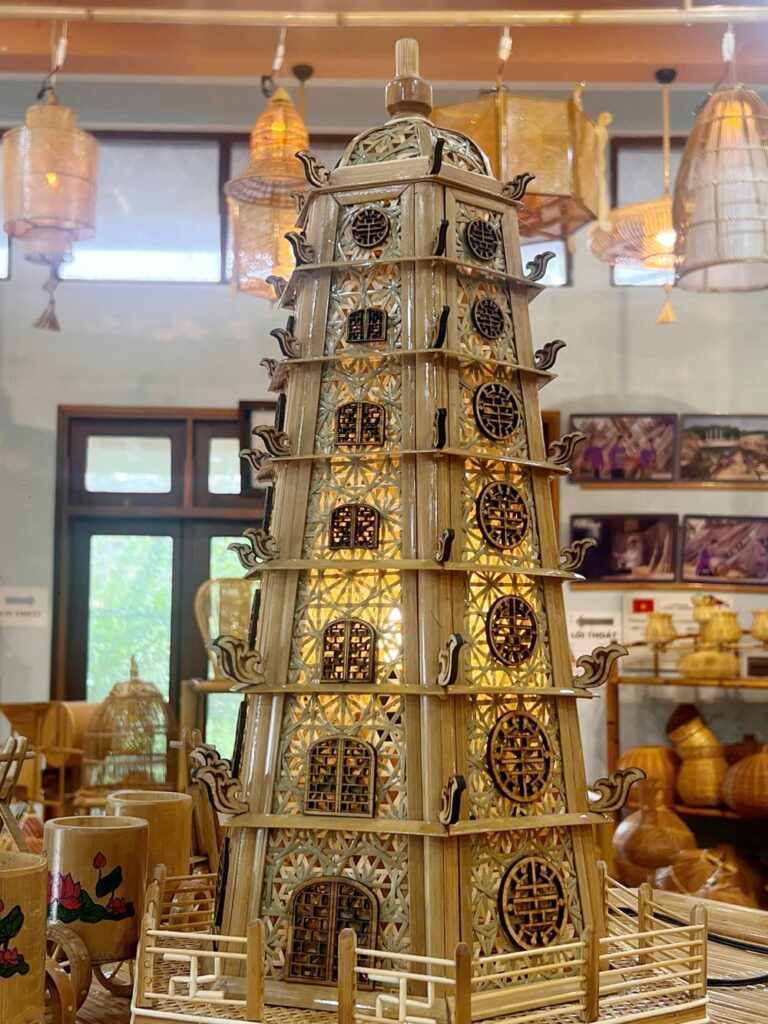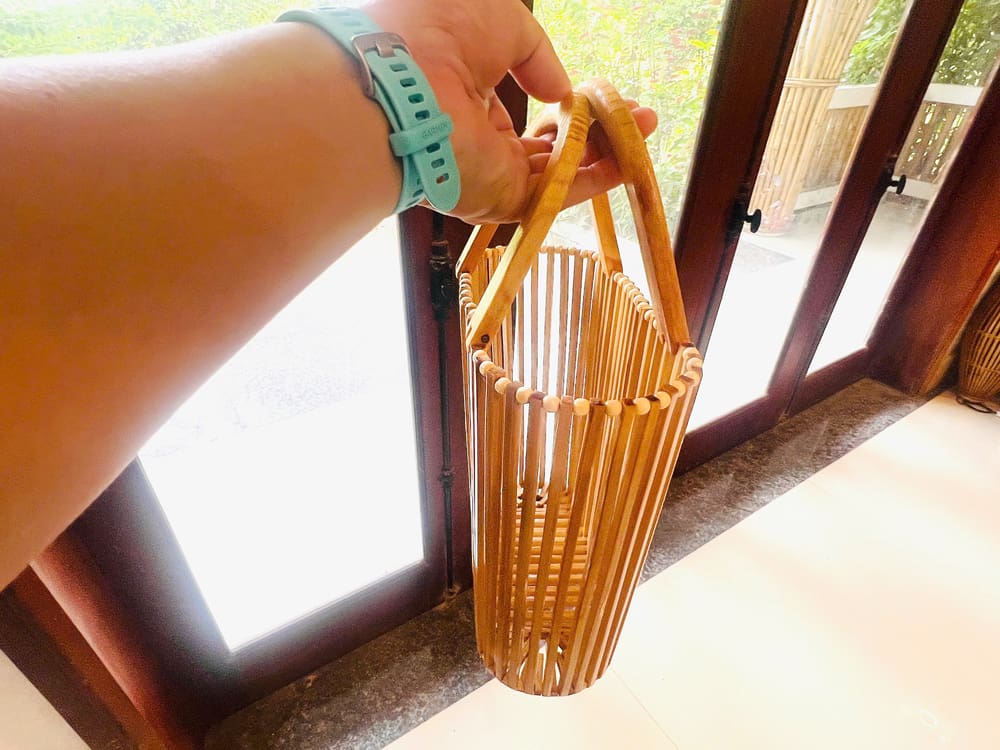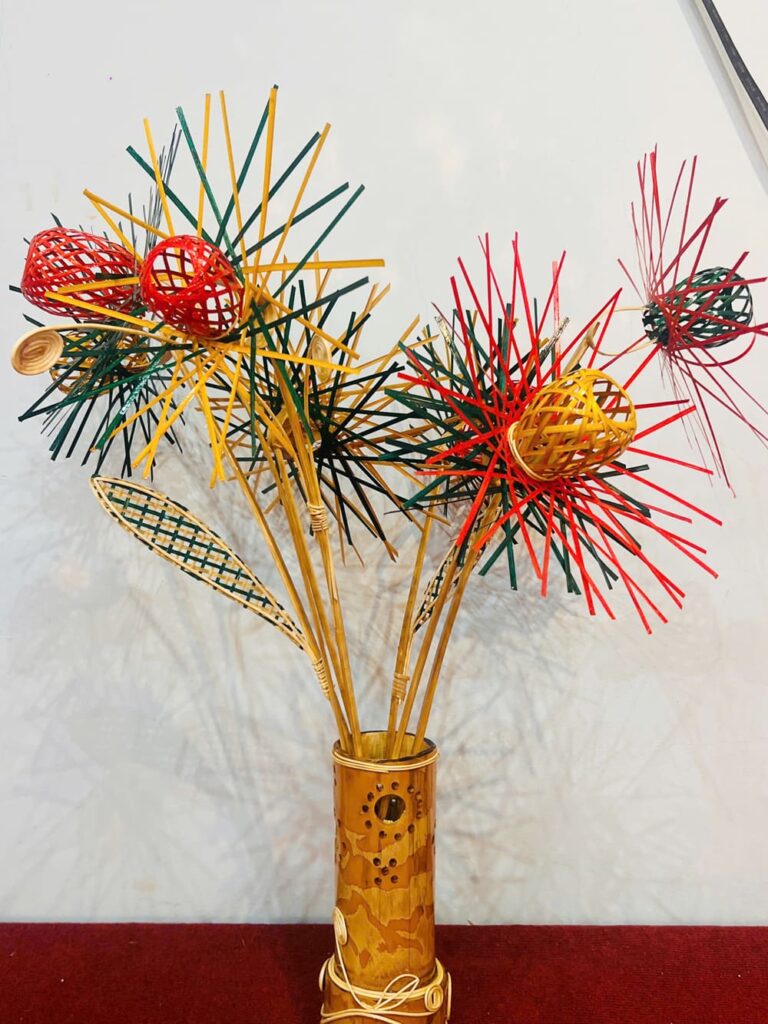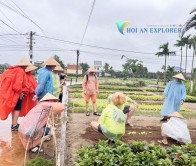Bao La Bamboo Weaving Village – A Morning in Quang Dien, Hue
I went to Bao La Village on June 12, 2025. It was around 8 in the morning, the sun in Hue hadn’t turned harsh yet, just a soft brightness over the rice fields. From the city, it took me about 40 minutes by motorbike to reach Quang Dien. The road was calm, green rice stretching on both sides, with a faint smell of young rice. Crossing An Lo Bridge, I slowed down a bit, letting the river breeze cool my face.
Bao La Bamboo village didn’t look like a tourist spot at first glance. It felt like a normal village. Narrow lanes, red-roof houses, lots of trees. People sat in front of their houses, hands moving quickly over thin strips of bamboo. The sound of splitting and weaving, mixed with laughter. Not staged, not commercialized. That’s what struck me.
See more >>> Hoi An Bamboo Handicraft Workshop at Cam Thanh Coconut Village.

Stories from bamboo and hands
One old man, maybe around 60, told me, “This bamboo must be soaked in mud for a month to be flexible; otherwise it breaks.” He let me try bending a strip. It really was softer, more elastic. Watching him weave a basket, I realized each piece takes hours. Nothing fast about it.
A younger woman was making bamboo lampshades for an order heading to Hanoi. Price: around 180,000 –200,000 VND per piece. She laughed when I said it looked fancy enough for a design shop. That’s when I noticed: Bao La Bamboo village handicrafts weren’t just for rural households anymore. They were evolving. You could see chairs, lamps, planters — designs that fit right into modern cafés or homestays.

I bought a market basket.
The kind my grandmother used when going to the village market. It cost me 150,000 VND. Strong, neat weaving. The seller said it could last 5–7 years if kept dry. I carried it around the rest of the day, a bit amused. Weeks later, I even brought it to a supermarket in Hue — people stared. In Da Nang, a foreigner asked me where to buy one. Small thing, but memorable.

Bao La Bamboo village feels different from other craft villages
For example, Thanh Ha pottery village, Cam Thanh cooking class village, or Hoi An Bamboo village are crowded, full of tourists, and shops with fixed prices. Bao La is quieter. People don’t “perform” their craft. They just keep working, whether you’re there or not. If you buy something, it’s a bonus. If not, no problem. That sincerity felt rare.
It reminded me of Cam Ne mat weaving village in Da Nang, where the craft is fading and visitors need an appointment. Bao La Bamboo village, on the other hand, is still alive. There’s a cooperative, regular orders, and actual income. That’s why the craft continues — because it still pays the bills, not only because it’s “heritage.”
Some numbers I noted down.n
The Bao La Cooperative produces around 250- 3000 items per year. Main markets are Hue, Da Nang, and Hanoi, with some exports to Japan and Korea. Average income for artisans: 5–8 million VND per month. Skilled workers can reach 7–10 million. Not huge, but for rural life, it’s a decent balance — staying home, taking care of family, while still earning.
Half a day slipped by
I planned to stay an hour or two. Ended up spending almost half a day. Drinking tea, watching hands move over bamboo, chatting. There was an 80-year-old woman still weaving, her hands trembling but steady enough. I asked why she kept working. She smiled: “I weave so I won’t feel bored.” That line stayed with me. For her, weaving wasn’t just income — it was rhythm, life.
Practical tips if you’re going
Search for h Bao La bamboo weaving village, Hue, or just “Bao La, Quang Dien” on Google Maps. About 12 km from the Hue city center, an easy ride by motorbike. Go in the morning. Afternoons, people may head to the fields. For shopping, head to the Bao La Cooperative. Prices are fair, listed clearly.
Typical products
- Market basket: 60–80,000 VND
- Large bamboo tray (nia): 100–120,000 VND
- Hanging lampshade: 250–400,000 VND
- Bamboo chair: 600,000 – 1.2 million VND
- You can even request custom sizes for home decor projects.
My takeaway
Every handcrafted item feels warmer. Different from a plastic basket made by machine. The Bao La basket I use now has its quirks — uneven tones, slightly thicker strips here and there. But that’s the charm. It’s not perfect, but it has soul.
For me, Bao La is not just about craft. It’s about resilience, patience, and the slow pace that still defines Hue. If someone asks where to go beyond tombs and pagodas, I’d say: head to Quang Dien, sit with the weavers, and see life flowing in bamboo strips.



